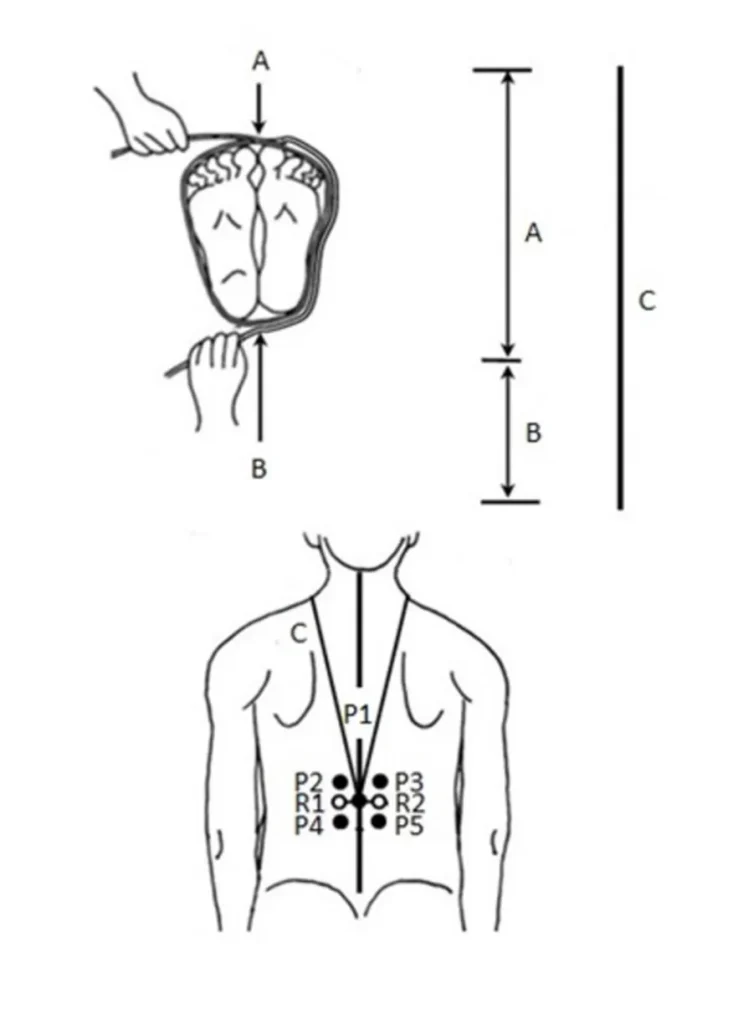If you’re not familiar with jôsetsu-hô, it’s a traditional Japanese moxibustion method that uses string measurement and palpation to locate highly effective moxa points. Rather than relying solely on fixed anatomical landmarks, practitioners use a proportional measuring system, using string or a measuring triangle, to guide treatment and locate the points.
This is really interesting. To give you an example, to treat headache, you wrap a piece of string around the head at the level of the forehead. Then you get that same length of string and put it round the neck at the level of the Adam’s apple and drape it backwards, so the ends meet at the posterior midline. The point for headache is at the ends of the string!
To give you more sense of how it works in practice, here’s an extract from Felip Caudet’s new book The Lost Art of Jôsetsu-Hô Moxibustion.
A quick word of explanation: Felip uses a shorthand to explain the steps. The first thing he does is to get a measurement, and he assigns a letter to it, like A or B. This measurement is often used to get a reference point and he calls those R1, R2 etc. Reference points are not used for treatment, just as navigation points to the treatment points.
Finally, the measurement or the reference point can be used to get the actual treatment points and he calls them P1, P2, P3 etc. It’s very simple once you start doing it and the illustrations are childishly simple. The jôsetsu-hô technique below is for abdominal pain. I think you’ll find it useful!

Abdominal Pain
These five points can be used on all types of abdominal pathologies. In particular, they treat abdominal pain coming from the stomach, intestines, uterus, bladder, gall bladder or urethral tract. Applying the right number of cones is important, easily reaching 30 cones per point. In all cases, however, the dosage should be adapted to the patient’s condition, using fewer cones if they are weak and more if they are robust. Occasionally, abdominal pain and diarrhoea may occur during treatment, although both symptoms are considered benign.
Applications
Non-recurring, acute abdominal pain.
Method
- Put the patient’s feet together and wrap the string around the perimeter of both feet: (A).
- Wrap the string an extra half-turn around the perimeter of the feet (B). This gives you a perimeter and a half: (C).
- Loop the string around the neck at the superior margin of the laryngeal prominence, with the ends of measurement (C) meeting inferiorly on the posterior midline. P1 is located on the midline.
- To locate the remaining four points, measure 1 cun laterally on either side of P1 to get R1 and R2. From these two reference points, find P2 and P3, 1 cun superior, and P4 and P5, 1 cun inferior.
If you’d like to explore more of these elegant and practical techniques, The Lost Art of Jôsetsu-Hô Moxibustion is available now in paperback and Kindle, with a launch discount until 31 July:
📘 Buy on Amazon
📘 Buy on Amazon France
📘 Buy on Amazon Australia
BUY BOOKS AND MOXIBUSTION PRODUCTS IN THE ONTAKE SHOP
Please share this post with colleagues who love moxa. Let’s revive the lost art together.
CHECK OUT MORE TITLES ABOUT JAPANESE ACUPUNCTURE AND MOXIBUSTION AT SAYOSHI BOOKS